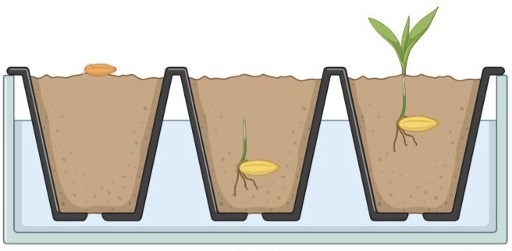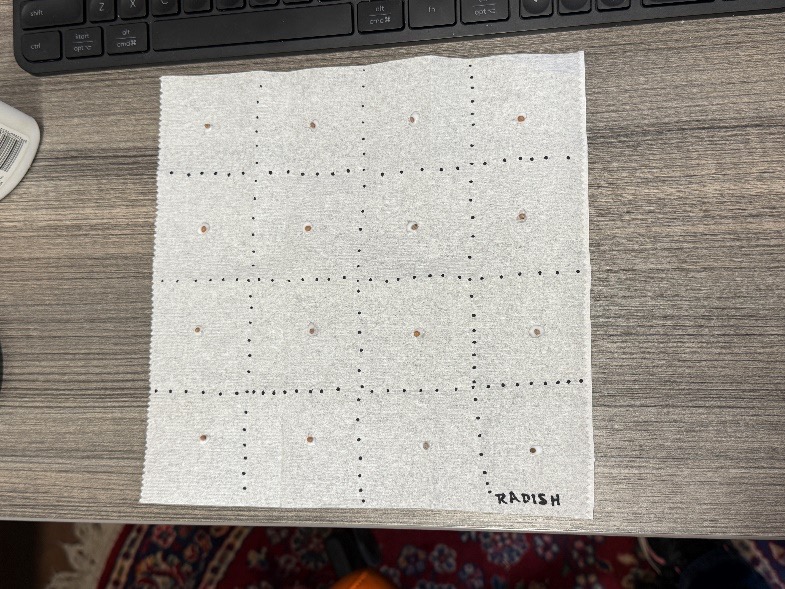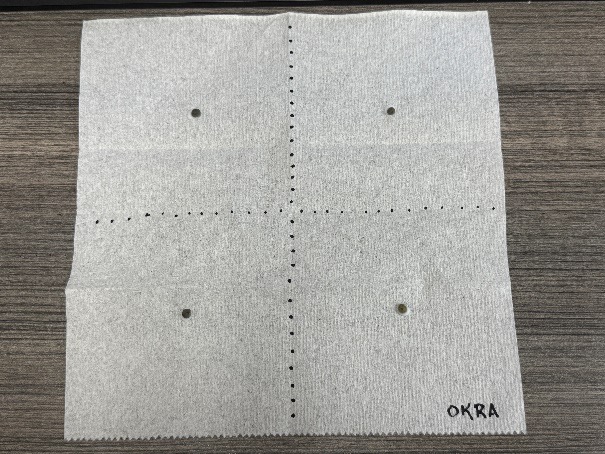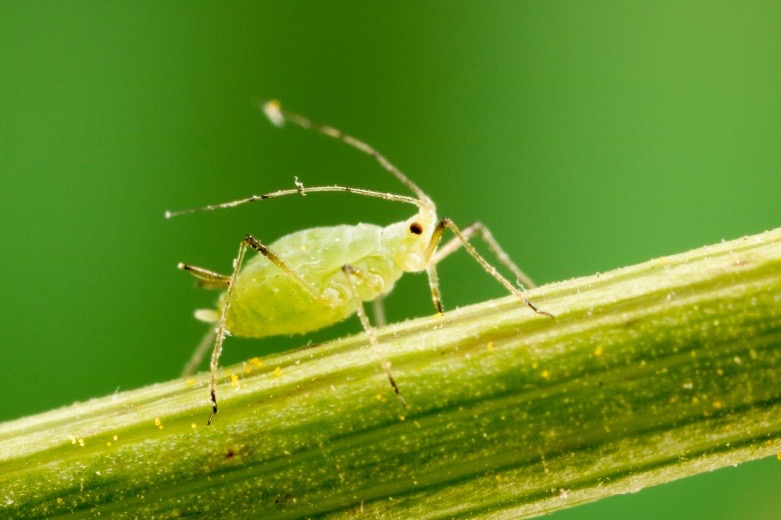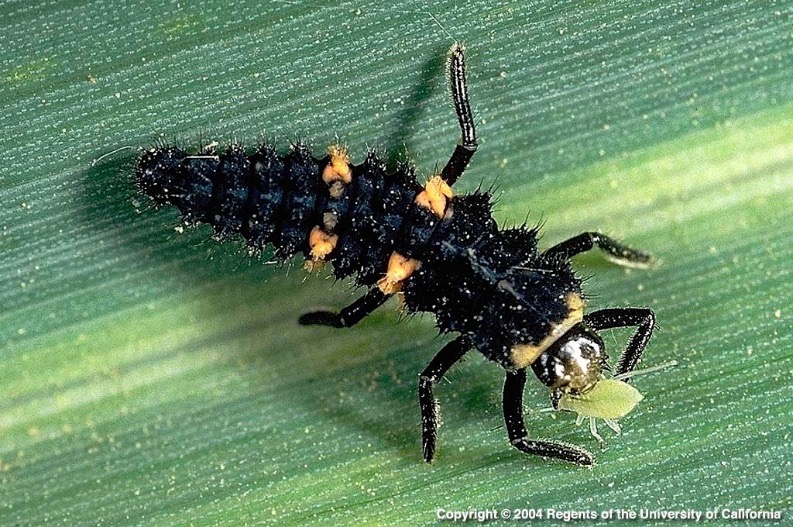Plants in the Classroom: School Garden Quick Start Guide
Let the Students Do the Work
Students and learning are the reasons for school gardens. They should be in on every decision. If only adults work in the garden, it will not be a school garden; it will be a field trip. Students should have all the key roles (design, layout, plant selection, etc.) with adult guidance or appropriate research. Only then will they have ownership and interest. School gardens are most successful with student investment in the garden through work and harvest.
Start small. Gardens can be 5-gallon buckets, pots under lights, a raised bed or a space in the ground.
Go slow and do not get discouraged. Try new plants, techniques, etc. Mistakes make the best lessons. If something doesn’t work out like you intended, ask the students what they think went wrong and what they can change when they try again. It is THEIR garden, after all.
Location
- Indoors - Plants that will produce food usually need bright light to grow and produce. A windowsill is not enough light. Use long tubular lights (even a shop LED light works) to cover all the plants. Keep the lights very close to the tops of the plants (a few inches for seeds, and no more than 12 inches for larger plants. As the plants grow, raise the height of the light to keep it just above the plants but not touching them. You can stack books to raise the light or shorten chains that may come with the light itself. Keeping the light close will help prevent etiolation (plants that grow long and sideways looking for the light). Many garden plants can be started this way and then transplanted to the garden as seedlings, giving them a better chance of establishment.
- Outdoors - Plants that produce fruits and vegetables need 6-8 hours of direct sunlight per day. Direct sunlight means not under trees, not shaded by taller plants and not just early morning or late afternoon sun.
- Make sure the water source is nearby as watering will be a frequent if not daily task. Water needs to be easily accessible with a hose or buckets for watering. Using a distant water source will require a very long hose or buckets to be carried to the garden.
- Locating the garden close to the school building ensures the garden will get more attention and provide more opportunities for engagement with the students. The more convenient the garden, the easier it will be to tend.
- Have a place for storing garden tools out of the weather. A small shed or plastic trunk works fine. Tools and gloves, watering cans, etc., can be stored in bins or on shelves.
- Make sure there is a locked area for any chemicals that will be used to keep children from accessing them. Even if you are planning to maintain an organic garden, there are likely chemical materials to lock up, such as bleach for sanitizing tools.
- Microclimates are important to consider when planning a garden. The north side of a building often receives more shade and is therefore cooler. The south side gets the hottest because the sun is in the southern part of the sky (in the northern hemisphere). The east only gets morning sun in the cooler part of the day, and the west gets full sun during the hottest part of the day. Also, the proximity to the building is a factor. A garden placed directly against the north side of a building will likely stay shaded all day but may receive more sunlight 20 feet off the building. A garden located directly against a south or west facing wall can be affected by the radiant and reflective heat from the wall. Consider this when locating the garden and selecting plants.
- Make sure the area immediately around the garden is big enough for multiple classes of students to work in and around the garden, sit, etc.
- A fenced-in area will help keep animals out of the garden.
- If the garden area is on concrete, you can still garden there by making a raised bed. Put several layers of cardboard and newspaper down then add layers of straw, peat moss, wood chips, vegetable scraps from from lunches and/or compost then top off with garden soil. This will elevate the garden off the concrete, give you a place to plant and you may even get a bonus vegetable plant from the cafeteria. Make sure that there is proper drainage for water. Over time, all the layers will break down into a nice soil. [See factsheet HLA-6448 Backyard Composting in Oklahoma.]
Size
- There is no standard size for a garden. Don’t start big. Start with a small container or one raised bed until you feel confident. Many enthusiastic people start with more than they can easily manage, only to get overwhelmed and quit.
- For raised beds, make them 4 feet across at most (or 3 feet for the younger children). This allows children to reach the halfway point from either side, reducing the need for them to climb into the beds (stepping on plants, compacting the soil, getting muddy, etc.). The beds can be as long as desired, but keep in mind, people will have to walk the distance of the row to get around to the next. Avoid putting raised beds up against a fence thereby preventing the use of one side of the garden. If it is necessary to locate next to a fence or wall, the bed should be narrower (no more than 2 feet across) so all areas of the bed can be easily reached.
- If several beds are constructed, ensure an aisle width of at least 8 feet. Picture a child at each bed and a teacher walking between them with no crowding. Also remember potential equipment needs for the garden, such as a wheelbarrow and a lawnmower if located on grass.
Containers
- If it holds soil, it will work. Animal supplement (mineral) tubs, troughs, 5-gallon buckets and other reused containers are often free and work just fine. Let the children express their personalities with paint if aesthetics are a concern. If your container has a solid bottom, drill some holes in it for drainage. [See factsheet HLA-6458 Container Gardening.]
- Old used tires work well for growing. When full of soil, they will not move, and lawn equipment cannot break them on contact. There is no scientific evidence that using old tires to grow food affects the plants or humans eating the plants in any way. You can always use tires to grow flowers with zero concerns. Of course, choosing to recycle tires in this way is up to you.
Raised Beds
- Raised beds allow for growing above the ground, which allows better drainage as well as the ability to use bagged soil easily.
- Raised beds can be made from anything or just left as a pile of soil on the ground.
- Raised beds can be made to any height, making access easier for students and teachers. A deep bed doesn’t have to be filled completely with soil. Placing branches, compost, or other organic matter in the bottom will help decrease the amount of soil you need to add and makes filling the bed a lot cheaper. You only need about a foot of soil to grow most things.
- To prevent the areas between the beds from becoming a muddy mess, lay down mulch, pavers, landscape fabric, even burlap coffee bags. It doesn’t have to be expensive to work.
- [See factsheet HLA-6033 Raised Bed Gardening]
Basic Garden Tools that will Come in Handy
- Watering cans for students to gently water the plants
- Water hose with spray nozzle (for watering, cleaning soil off garden tools, etc.)
- Hand trowels for students to dig holes for plants (hard plastic ones are fine)
- Round and/or flat shovel to add compost or mulch and dig bigger holes
- Garden rake for leveling the soil before planting
- Garden hoe to chop weeds at the soil line
- Garden twine, if you need to trellis plants
- Gardening gloves for little hands
- Plant labels, which can be store-bought or made from popsicle sticks, plastic spoons, etc. Pencil often lasts longer than marker or ink under sunlight (UV exposure).
- A wheelbarrow or cart for moving large amounts of soil or mulch and collecting the harvest
Soil
- When planting indoors or in containers, use potting soil. Bringing in outside soil is not recommended, as it potentially contains (plant) disease organisms, insects, etc. and is too dense for proper drainage and seedling germination.
- There are different types of soils. Potting soil (which contains no actual soil) for indoor use, as well as for some outside containers, has a lot of lightweight components that will blow away in wind. For outdoor use, use potting soil or bagged soil labeled for garden or container use and usually found at greenhouses, nurseries and farm stores. Topsoil can also be used, but be sure to screen the soil for potential weeds like nutsedge.
- When planting, backfill by gently pressing soil around the plant roots. It is not beneficial to put all your weight on your hands or to use your foot when doing this as it will compress the soil too much. Roots need to “breathe.”
- Digging in wet soil can lead to compaction. Wait until the soil is dry to work in it.
- Between growing seasons, incorporate compost into the garden soil to improve soil nutrients. Aged horse manure makes good compost. Fresh manure has a lot of salt that can burn the plants and may contaminate the soil with microbes, such as E. coli or Salmonella. Aged manure (which won’t look like manure anymore) still has the nutrients you need without the potential issues. Some municipalities collect yard waste and turn it into compost available to the public.
- Fertilizers may be added at planting and/or later while plants are growing, depending on the species of plant. A balanced fertilizer, such as 10 – 10 – 10 (NPK) should be fine for most gardens. Depending on the form of the fertilizer, there will be instructions on application. Fertilizers are salts. If you apply too much, it can be detrimental to the plant. This is one reason to water thoroughly (whether inside or outside), to help leach any fertilizer buildup away from the plant.
- For outdoor gardens, a soil test (through your local OSU Extension office) is recommended prior to planting (November-February) to have a baseline understanding of the soil pH and nutrient levels. If amendments need to be made, this will allow time between growing seasons to add whatever is needed (the soil test results will say exactly what is needed).
Watering
- Plants have different watering requirements. Some like to be kept dry for long periods between waterings, and some like a moister environment. In general, an inch of water a week will suffice. Check the seed or seedling package for water requirements and try to group similar water needs together. For instance, you wouldn’t put a cactus next to a plant that needs a lot of water.
- You can water using a hose, sprinklers or watering cans. You can also install irrigation, but for children to own the garden, they need to be the ones watering the plants. Save irrigation for vacation breaks when no one will be around to care for it as often.
- When you water, it is better to do a deep watering at one time than a lot of short waterings. If you water small amounts frequently, the plants will keep most of their roots at the surface and be less sturdy to winds and water forces as well as less hardy for survival during drier conditions. Furthermore, keeping the roots continuously moist can lead to fungal problems.
- Water at the base of the plant. This will keep the leaves dry and help reduce the spread of pathogens.
What to Grow
- Students will eat what they grow. Try expanding their palate with beets, beans, rutabagas, mixed greens or anything else they might find exotic, or just stick with the basic carrots, lettuce, tomatoes, onions, etc.
- Ask the students what they want to grow. They will have more interest in the garden if they have buy-in.
- Themes can be a fun and creative way to design a garden. You can grow things that settlers grew, make a native garden or pollinator garden, grow flowers (and sell bouquets), create a salsa garden (and sell salsa), etc.
- Check (on seed packet, at Extension office, using online fact sheets) to see if what you want to grow will be successful in your climate at that time of year. [See factsheet HLA-6004 Oklahoma Garden Planning Guide]
- To plan an end-of-season salad day or pizza day celebration, count backward from listed harvest days to figure out planting dates to ensure ingredients (basil, tomatoes, etc.) all mature at the same time. It may be necessary to start plants indoors.
Planting
- When sowing seeds, the general recommendation is to plant a seed twice as deep as
the size of the seed. That way it is not so deep that the plant runs out of energy
before reaching the surface and not so shallow that it dries out in the sun or blows
away in the wind. For instance, pumpkin seeds are larger than carrots seeds, so they
are planted deeper.
Examples of seeds planted: seed too shallow (dried out), seed too deep (ran out of energy), seed at correct depth (reached surface and grew leaves). - When planting seedlings or transplants, gently remove them from their pots by turning the pot sideways or upside down with the stem between your fingers and squeezing or tapping the pot until the rootball falls out into your palm. Avoid pulling plants out by the stem. If the stem breaks your plant will not recover. The seedling should be planted at a depth that matches the soil level in its original pot; for example, if the soil in the pot is a ⅓ the way up the stem, it should be planted so that the garden soil is also ⅓ the way up the stem.
- When planning the garden, make sure each plant has enough space to grow and not be shaded out or competing with other plants for water and nutrients. Plant spacing information is on seed packets.
- An easy way to plant seeds and make sure they have enough space is to give each student
a paper towel (about a square foot) and have them glue (school glue) the seeds to
the paper towel so that the seeds are the proper distance apart. Each child can carry
their paper towel to the garden and cover it with soil.
Figure 1. Radishes can be grown 16 to a square foot.
Figure 2. Okra can be grown 4 to a square foot. - When deciding what to plant, it is important to know the average dates of first and last freeze for your location. Some plants can be started inside and then moved outside after the last freeze, while some are directly seeded into the ground after last freeze. In Oklahoma, the Mesonet (mesonet.org) can show you the average first and last freezes for your area. The average first freeze in Oklahoma ranges from October 17 to November 15 and the last freeze ranges from March 21 to April 20, though these dates vary throughout the state.
| Vegetable | Planting Dates | Days to Maturity |
|---|---|---|
| Bush bean (seeds) | Aug. 10 - 20 | 50 |
| Cabbage (transplants) | Aug. 1 - 25 | 75-90 |
| Cucumber (seeds or transplants) | Aug. 10 - 20 | 60-70 |
| Mustard (seeds) | Sept. 10 - Oct. 10 | 40-50 |
| Radish (seeds) | Aug. 15 - Oct. 10 | 20-40 |
| Spinach (seeds) | Sept. 5 - 25 | 50-60 |
| Summer Squash (seeds or transplants) | July 15 - Sept. 1 | 40-50 |
| Vegetable | Planting Dates | Days to Maturity |
|---|---|---|
| Beet (seeds) | March | 50-70 |
| Cabbage (transplants) | Feb. 15 - March 10 | 60-90 |
| Carrot (seed) | Feb. 15 - March 10 | 70-90 |
| Cauliflower (transplants) | Feb. 15 - March 10 | 70-90 |
| Green peas (seeds) | Feb. 15 - March 10 | 60-90 |
| Head lettuce (seeds or transplants) | Feb. 15 - March 10 | 60-90 |
| Leaf lettuce (seeds or transplants) | Feb. 15 - March 10 | 40-70 |
| Radish (seeds) | March 1 - April 15 | 25-40 |
| Spinach (seeds) | Feb. 15 - March 10 | 50-70 |
| Swiss chard (seeds) | Feb. 15 - March 10 | 50-70 |
| Turnip (seeds) | Feb. 15 - March 10 | 50-60 |
Maintaining
- The use of mulch will help preserve moisture, regulate soil temperature and reduce the number of weeds. Mulch should be natural (not plastic), so it can break down over time, and add organic matter to the soil. A two- or three-inch layer is deep enough to be effective.
- Vining plants, such as beans, tomatoes and squash, need to be trellised or supported somehow. Trellising plants helps save space as well as keep vegetables off the ground, where they are likely to rot. Cattle panels, chain link fence and stakes with twine connecting them are good cheap sources of trellises.
- Weeding is an important chore, especially with smaller plants. Weeds can grow and reproduce quickly. When you pull weeds, make sure to get the root. Be careful throwing weeds in the compost pile, as they could contain many seeds and perpetuate the problem. If you have mulched the garden, you should have fewer weeds to pull or cut.
- When parts of a plant die, it is best to remove the dead parts and compost them. If the plant has a disease, it is best to throw it in the trash so as not to spread the disease. Sometimes parts of a plant (especially leaves) turn different colors or show spots or stripes. These can indicate disease or nutrient deficiency. Your local Extension office can help you decide what is wrong and tell you how to deal with it.
- Learn to differentiate between beneficial insects and harmful pests. Pollinators, such as butterflies, wasps and bees, are good for your plants. Spiders like orb weavers provide natural pest control. Slugs and soft-bodied insects can be controlled by applying diatomaceous earth (which punctures their soft outer layers and dries them out) near and on the plant. Aphids can be knocked off plants with a strong stream of water. Ladybugs and their larvae eat hundreds of aphids, so let them do their work. Several natural and safe pesticides are available to help keep pests controlled. Contact your local garden center or local OSU Extension office for assistance.
Figure 3. Aphid photo by Gordzam, Adobe Stock.
Figure 4. Ladybug larvae eating an aphid - photo by Regents of the University of California.
Harvesting
Oklahoma does not currently have a law preventing schools from consuming produce grown in the school garden; some states do. This allows the students to “reap what they sow” and an opportunity in which they are often more willing to try their veggies after having grown them themselves.
| Produce | Harvest Signs |
|---|---|
| Beans, green | When they snap easily into two pieces |
| Beets | When you see the beet root protruding above the soil |
| Cabbage | Once head feels full and firm with gentle squeeze |
| Carrots | When top of carrot root protruding above the soil and diameter looks good |
| Cauliflower | When head looks full and the white part “the curd” is still smooth |
| Cucumber | Should be firm and smooth |
| Lettuce, Head | Once head feels full and firm with gentle squeeze |
| Lettuce, Leaf | When leaves are 4 inches tall |
| Peas | Pods look and feel full; taste to determine |
| Radishes | When you see the radish root protruding above the soil |
| Swiss Chard | Remove leaves about 8-12 inches long |
| Spinach | Remove outer leaves when desired size |
| Squash, Summer | When fruit is about 6 inches long, and skins are tender enough to poke with your fingernail |
| Turnips | When turnip root is protruding above the soil and diameter is about 2 inches at soil line |
Where to go for Help
All counties in Oklahoma have an Extension office, with educators who use science-backed data to help with questions in agriculture, family and consumer sciences, horticulture, and more. Many of their services are free. Some may be able to visit your school and give advice about your garden.
You can locate your Extension office and educators using the county website.
Fact sheets about gardening (and many other topics) are available for free at the extension website.
The horticulture youth specialist for the state of Oklahoma is Shelley Mitchell: email shelley.mitchell@okstate.edu.
Oklahoma Gardening is a great YouTube video resource.
The youth curriculum Junior Master Gardener is published by Texas A&M. Information about the program can be found at the Junior Master Gardener website.
Follow the Oklahoma School Garden Network on Facebook for information on upcoming trainings, grant opportunities, interesting videos and lesson ideas.

